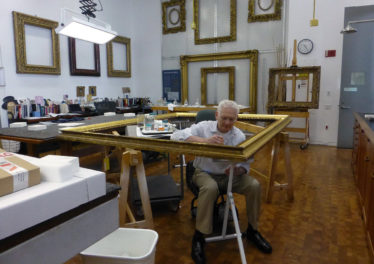
The Adoration of the Magi (detail), Simon Bening, about 1525–30. Tempera colors, gold paint, and gold leaf on parchment, 6 5/8 × 4 1/2 in. The J. Paul Getty Museum, Los Angeles, Ms. Ludwig IX 19, fol. 36v
Balthazar: A Black African King in Medieval and Renaissance Art, an exhibition at the Getty Museum, foregrounds images of Black and African people in European Renaissance and medieval art. This period marked the beginning of the transatlantic slave trade, and was a time when the construction of race was in flux.
Curator at the California African American Museum, and incoming curator at the Autry Museum, Tyree Boyd-Pates says the exhibition underlines a key message, “We’ve been here the entire time.”
Historically, images of Black figures in European art from this period have been largely ignored by curators and scholars. However, as Boyd-Pates points out, that’s an outmoded way of thinking.
“Whether there has been a success in erasure or not, that does not erase the fact that our presence was known, respected, and acknowledged even by those who we would deem as colonial powers.”

The Adoration of the Magi, about 1525–30, Simon Bening. Tempera colors, gold paint, and gold leaf on parchment, 6 5/8 × 4 1/2 in. The J. Paul Getty Museum, Los Angeles, Ms. Ludwig IX 19, fol. 36v. Digital image courtesy of the Getty’s Open Content Program
This image depicts one of the best-known events from the Christian Bible, in which three wise men bring gifts to Jesus Christ at his birth. In this interpretation of the scene from a Belgian manuscript created around 1525, one of the wise men is black.
“One could see the power in the representation of a black person or an African person in this context,” says Boyd-Pates. “These Magi are the kings who are underneath the King, which is the Christ. And I see a respect given to this section of the world that European power(s) realized was significant. This only underscores the value, the prominence, and the dignity that African people had captured in an image just like this.”
This is not just a religious scene, he says, but also speaks to the political and trade relationships between Europe and Africa.
“And these relationships are important because they not only chronicle how Europe saw their peers, but also spoke to how Europe would engage with their peers, not only religiously, not only historically, but also financially in order to economically become the power that it ultimately became,” he adds.
Hear more from Tyree Boyd-Pates as part of the audio tour for the Balthazar exhibition.
You can see this piece on view at the Getty Center through February 6,2020 as part of Balthazar: A Black African King in Medieval and Renaissance Art.




Comments on this post are now closed.